News and Events·
Library List
Mission Statement
Contact us
Carl Jung
Temenos
Other Jung Socs.
|
The Anima,
the Animus and the Yoginis
Richard Barz
I’ve been very much attracted to the
thought of Carl Jung for a long time. I find that his approach to life
resonates with mine. Especially do I feel drawn to Jung’s concept of the
anima, the feminine side of a man’s psyche, and the animus, the
masculine side of a woman’s psyche.
I
feel, for instance, that I’m in the presence of a kindred spirit when
Jung says on the subject of the anima:
“Although she may be the
chaotic urge to life, something strangely meaningful clings to her, a
secret knowledge or hidden wisdom, which contrasts most curiously with
her irrational elfin nature… This aspect appears only to the person who
gets to grips with her seriously. Only then, when this hard task has
been faced, does he come to realize more and more that behind all her
cruel sporting with human fate there lies something like a hidden
purpose which seems to reflect a superior knowledge of life’s laws. It
is just the most unexpected, the most terrifyingly chaotic things which
reveal a deeper meaning.”
Though Jung referred
to the animus almost as much as to the anima in his writings, he had
less to say about the animus in detail. In one of his brief formulations
on the subject he says:
“If… a woman comes under the domination of the unconscious, the
darker side of her feminine nature emerges all the more strongly,
coupled with markedly masculine traits. These latter are comprised under
the term ‘animus’”.
What is it that I find
attractive about those quotes? I think it’s the way that they express
difference. The anima and the animus aren’t so much, for me any way,
about a female entity or, speaking hypothetically a male entity, that is
different from the self that I’m conscious of. Rather they are about the
difference between what I know in myself that is me and what I feel in
myself that is not me.
It’s a difference that can be disturbing
and frightening because it brings to my attention something in me that
isn’t me. But that something is also alluring. I want to be complete. I
want to be what’s not me, too. Sometimes what isn’t me does take a
feminine form because that is the shape that seems most unlike me. Then
it would be, as Jung would agree, my anima. Logically, though, when what
isn’t me in myself doesn’t have a feminine form it is still my anima,
even though it doesn’t have a womanly appearance.
For example, I’ve felt from my teenage years
an attraction in myself to foreign things in general and foreign
languages in particular. This attraction has no feminine guise. When I
discovered in myself an enthusiasm for Indian culture and language, I
felt overjoyed because I had found just about the most different ways of
approaching the world that I could conceive of. Those different ways of
doing things when brought within myself are, in my view, also part of my
anima though in no way feminine.
When I learned that
Carl Jung shared my intrigue with India, I tried to read all of his
accounts of his experience with Indian thought. That’s how it came about
that last year at the November meeting of the Jung Society, I gave a
talk on Carl Jung’s encounter with
kundalinī and his interpretation
of
tantra.
This evening’s talk will take up where that one left off.
For those who weren’t at the talk last year, kundalini, Sanskrit for
‘something that is female and coiled’, is the divine power,
shakti
in Sanskrit, visualised as a female snake sleeping at the base of the
spine of every human being. Tantra, also a Sanskrit word, refers both to
a method of mental, physical or magical practice and to a text of
instruction in such a practice. The quintessential tantric practice is
the awakening of kundalini.
In the course of the November talk I
discussed certain female aerial spirits called
yoginīs, dangerous sources of supernatural powers that could be
acquired only in secret through esoteric, fearsome nocturnal tantric
rites. Between the 9th and the 14th centuries
the identity of the yoginis bifurcated.
On the one hand, they
were transformed by mainstream Hindu tantric philosophers into the
kundalini shakti that, once awakened, can rise from the base of the
spine in stages called chakras
through the body to bring a man or woman to union with the conjoined
Shiva-Shakti male-female form of the supreme being. This transformation
has evolved through the tantra encountered by Jung at the end of the
second decade of the 20th century into the type of tantra
typical of contemporary global culture.
On the other hand,
occult worship of the yoginis through tantric ritual- both forbidden and
abhorrent to ordinary people- was taken up by kings and aristocrats,
especially in central India, usually for the attainment of irresistible
political and military power. Under the patronage of such wealthy and
dominant individuals, temples of stone and brick were built for the
worship of yoginis. Most of these temples were round, though a few were
rectangular in shape, but all of them consisted of chambers arranged
around an unroofed courtyard.
Each of the chambers, in some
yogini temples numbering 42, in others 64 and in still others 81, held
the image of a specific yogini. The central courtyard had to be open to
the sky so that yogini spirits corresponding to one or another of the
yogini images could fly in for the night-time ritual. That ritual was
seen as a sacrifice to a yogini involving the offering and consumption
of meat- including human flesh- alcoholic beverages, blood and semen.
These tantric practices would culminate with sexual intercourse with a
real woman possessed by a yogini spirit and would hopefully, but never
certainly, result in the male practitioner’s acquisition of
extraordinary power from the yogini.
The activities in the
yogini temples seem to have been linked with the composite supreme being
Shiva and Shakti by a shrine or pavilion in the centre of the open
courtyard dedicated to Shiva in his own form or in his ferocious
manifestation as Bhairava
and a chamber in the enclosing wall reserved for Shakti as Durgā
or Mahāmāyā
or another of her forms. This link indicates that worship in yogini
temples included observances aimed at more than the mere gaining of
mundane power. All that talk about eating human flesh and drinking blood
might be weird and attractive in a revolting kind of way, but it didn’t
really speak to me. I wasn’t about to raid a blood bank or dig up bodies
for a feast in the cemetery. But the pavilion in the centre of a yogini
temple suggested that there might be more depth than I thought in
yoginis and their worship.
In construction the yogini temples are unique
among Hindu religious structures since very few other Hindu temples are
round and the inner shrines of all other Hindu temples are roofed over.
While Hindu temples are usually inside cities, towns and villages,
indications are that yogini temples tended to be situated in isolated
places.
That is as far as my talk last year went. At
the end of the talk I said that on the very next day I planned to go to
India with my friend and colleague Barbara Spode, who is here tonight,
to see the remaining four round yogini temples, including the three that
still contain yogini images in their chambers. We did go to India, but
we managed to see only three of the temples on that trip. The fourth
one, the round yogini temple with its yogini images at Ranipur-Jharial
in rural inland Odisha, will have to be the goal of another journey.
This evening I’d like to visit with you the rectangular yogini
temple at Khajurāho in the Indian state of Madhya Pradesh and three of
the round yogini temples, two also in Madhya Pradesh at Mitauli
(Mitāvalī), near Gwalior, and Bheṛāghāṭ, near Jabalpur, and one at
Hīrāpur, near Bhubaneshwar in the state of Odisha.
I’ll use photographs I took at Khajuraho in 2007 and at the 3 round
temples in 2017 to make our visit more vivid. We’ll also look at some of
the yogini statues that remain in two of these temples and discuss some
features they have which seem relevant to C.G. Jung’s concept of the
anima and animus.
The Yogini Temples
The
location of the rectangular yogini temple at Khajuraho is indicated with
a gold star on this map of India. Marked with red stars are the three
round yogini temples at Mitauli, Bheraghat and Hirapur. In addition to
these and the temple at Ranipur-Jharial, there are also a few completely
derelict yogini temples in remote parts of central India. Scattered
among museums in India, North America and Europe are yogini sculptures
that have been removed or stolen from derelict or existing yogini
temples.

None of the 5 surviving yogini temples
seems to have been continually consecrated for worship throughout its
history and all of them show signs of iconoclastic damage in the past.
Since there is no written account of attacks on these temples by
idol-hating Muslim raiders, the cause of the damage to them seems to be
the work of other, unknown agents. There has been speculation that the
temples were assaulted by mobs of people disgusted by the excesses of
tantric rituals, but there is no historical verification for such
disgust or resulting assaults. In at least two of the temples the
overturned and desecrated yogini images were set up again and restored
to worship for an unknown period of time.
All of the temples were more or less abandoned
before modern times. Vestigial Hindu worship is being carried on at the
Khajuraho and Mitauli temples and worship of Shiva’s phallic linga
emblem is conducted at Bheraghat but, of these 4 yogini temples, only in
the Hirapur temple are yogini images being formally worshipped today.
I’ll only be able to report on the situation at the fifth temple at
Ranipur-Jharial after I have been there as, at least until now, academic
accounts of the yogini temples have nothing to say about contemporary
worship. It is not yet known whether or not tantric rituals are
currently being practiced in any yogini temple.
The Yogini Temple at Khajuraho
The ruined rectangular 64 Yoginis Temple at Khajuraho is at a short
distance from, but still in sight of, the magnificent temples for which
that place is famous. The temple, built in the mid 10th
century, is centred on a large courtyard which may once have contained a
shrine to Shiva as is the case at other yogini temples. The courtyard is
now completely empty. 65 chambers were set into the walls of the temple,
with the central chamber in the end wall being taller than the others.
In 1955 three images, two with ancient identifying inscriptions, were
present in the temple and were photographed. Two of the images were of
yoginis, and the third, in the taller chamber, was of the Shakti Durga
killing the buffalo demon. The photos still exist but it is not clear
where the images are.
They were absent from the temple in 2007 and had not been seen there for
many years. Although there were no images in the temple, in the taller
chamber there were implements for the worship of Shiva alone or together
with Shakti that were evidence for the performance of informal rites.
These implements can be seen in a photograph on page 11 of my November
2017 talk at the Jung Society available online.
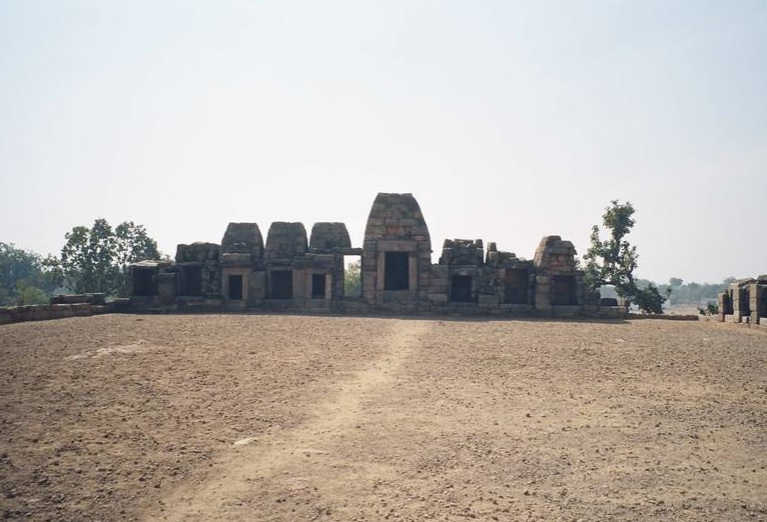
Photo: R. Barz, 2007
Rectangular 64 Yoginis Temple
at Khajuraho, Madhya Pradesh, c.950 CE
The
64 Yoginis Temple at Mitauli
Since, where possible yogini temples were constructed on high
ground, the 64 Yoginis Temple at Mitauli dating from the 11th
century stands upon a lofty hill. By the beginning of the 20th
century the temple had fallen into ruin but, at that time, it was
restored as a historical monument. It is built around a large central
courtyard in the middle of which there is a pavilion, probably where an
image of Shiva/Bhairava was once established. Like the Khajuraho yogini
temple, the Mitauli temple has 65 chambers, one with decoration more
elaborate than the others.
Again as at Khajuraho, it may be that
the more decorated chamber was for Durga or another of Shakti’s forms. A
dated inscription on the temple indicates that it was still being used
for worship in 1503, but none of the yoginis once established there
remain. In their place a linga has been set in each chamber with two
more in the central pavilion and people in the area consider the temple
a shrine to Shiva. Although a 100 rupee note offering had been placed on
one of the lingas in the pavilion on the day of our visit, currently
there is no priest in residence and the temple has not been
reconsecrated. Mitauli Yogini Temple is not on the national or
international tourist circuits though it is popular for excursions by
local school groups.

Photo: R.
Barz, 2017
64 Yoginis Temple with Central Pavilion at
Mitauli, Madhya Pradesh, c.1075 CE
The Temple of 81 Yoginis at Bheraghat
Like the Mitauli temple, the 10th
century Bheraghat yogini temple, also on the crest of a hill, was
rescued by archaeologists from a state of decrepitude. It includes a
Hindu temple of standard north Indian design built when the yogini
temple was already some two centuries old, perhaps on the spot of an
earlier pavilion for Shiva/Bhairava. Unlike the Mitauli and Khajuraho
yogini temples, the Bheraghat temple retains its statues, though eight
of its original 81 yoginis have been replaced by the images of other
deities brought some time in the past from other places.
The
statues in the other 73 chambers are of yoginis sculpted for the temple.
Although most of the statues are badly broken, their exquisite beauty is
still apparent. All but 10 of the yogini sculptures have their names,
carved in ancient times, on their pedestals. Because this temple is
located above an impressive marble gorge on the Narmada River which is a
national tourist attraction, it draws a fairly large number of visitors
each year. Signs of informal worship- flowers and little clay oil lamps-
are at the feet of some of the statues. More formal worship of three
Shiva lingas is conducted at the temple in the central courtyard.
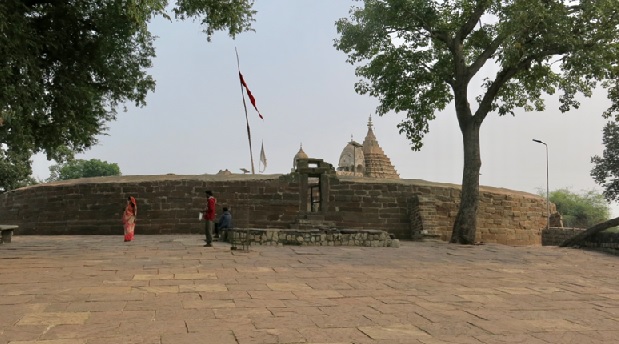
Photo: R. Barz, 2017
81 Yoginis Temple, c.900 CE, with the 12th
Century CE Central Shrine at Bheraghat, Madhya Pradesh
The 64 Yoginis Temple at Hirapur
The Hirapur temple for 64 yoginis, constructed around the beginning
of the 10th
century, is the smallest but best preserved of the four temples under
discussion. It also has beautiful yogini statues that are more or less
intact, though they are neither identified by ancient labels nor
mentioned in tantric texts. 60 of the yogini sculptures are in chambers
in the surrounding walls, with an image assumed to represent the Shakti
Mahāmāyā singled out for special worship. This has resulted in the image
of Shri Mahamaya and the yogini images to her right and left being
entirely hidden from view by religious paraphernalia. Three more yoginis
are in niches in the walls of a small pavilion in the centre of the
temple courtyard. A fourth niche is empty and it is not known when the
yogini image originally there disappeared. The central pavilion also
contains four statues of Shiva as Bhairava. There was an image of Shiva
in the centre of the pavilion, but it was stolen soon after the temple
became widely-known in 1953. The temple has a staff of priests who look
after it and carry on a regular schedule of formal worship.
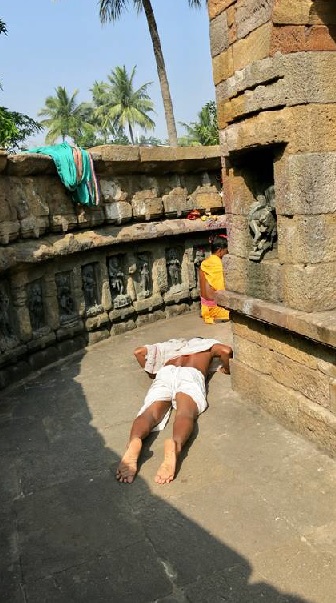
Photo: R. Barz, 2017
Priests in the 64 Yoginis Temple at Hirapur, Odisha, c.900 CE
The Yogini Images at Bheraghat and
Hirapur
Although active around the same time, there is no evidence that the
creators of the yogini images at Bheraghat and Hirapur had any contact
with each other. In artistic style the two groups of yoginis are quite
distinct but they are closely related in iconography. For instance, most
of the yoginis in both temples have the faces and bodies of beautiful
women with voluptuous breasts, slender waists, wide hips and firm,
sensuous thighs. Even those with the head of a horse, a sow or some
other animal still have physically attractive feminine bodies.
The animal head is
not meant to be ugly or off-putting but rather to indicate the
particular nature of a yogini and her status as a shape-shifter at the
interstices of the worlds of beasts, human beings and deities. Nearly
all of the yoginis at Bheraghat and Hirapur, as is common with the
images of most Hindu divinities, stand upon an entity, usually an
animal. This entity is thought of as “carrying”, that is to say
expressing the essence of, the yogini and is, therefore, known as the
yogini’s vehicle- vāhana in
Sanskrit. Many of the Bheraghat statues- though none of the Hirapur
yoginis- are accompanied by friezes of male and female figures, both
human and demigods, and mythical and real animals. These act to enhance
the effect of the yogini’s image.
As an example of a typical
Bheraghat yogini sculpture, I have chosen Shri Kshatradharmini, Sanskrit
for ‘auspicious (śrī) female
(suffix –iṇī) duty (dharma) of dominion (kṣatra)’.
She is seated on a lotus throne on a pedestal in the 78th
chamber counting from the left of the entrance to the temple. Her face
has been destroyed so that it cannot be said whether her head was animal
or human though she seems to have the ears of a woman.
Before
going further into her image, I should say something about Shri
Kshatradharmini’s name. She is the Auspicious Lady who has the Duty of
Dominion. But what does that actually mean? Dharma is the main component
of her name. It comes from the Sanskrit verbal root
dhṛ ‘to hold, to carry’. In
Hinduism and Buddhism it refers to the proper way to hold one’s life. It
is the rule of life. It is the correct way of doing things. It is
morality, duty. Next comes kshatra ‘dominion, supremacy, power’. Shri
Kshatradharmini is the Lady who has the dharma of power.
Now to
go on with what she looks like, Shri Kshatradharmini is portrayed
wearing a crown decorated with three severed human heads and a sash to
which another head and two hands are affixed. The severed heads and
hands make clear that she holds dominion over life and death for those
who submit to her. They also denote that Shri Kshatradharmini can sever
those who trust in her from the perils of worldly existence and deliver
them into a state of transcendent life. Shri Kshatradharmini shows the
way to the correct use of power to overcome the negative forces in life.
The key to the inner
meaning of Shri Kshatradharmini is the vehicle that carries her. The
yogini’s vehicle is a composite animal with the body of an elephant and
the claws and tail of a lion which proclaims the elemental, fierce force
of her nature. Around the neck of Shri Kshatradharmini’s powerful animal
is a chain that means she has her power under absolute control.
Above Shri Kshatradharmini are groups of male
and female celestial spirits singing her praises. In front of her
fantastic animal vehicle are clustered three female figures preparing
for a tantric rite of transcendence. Two of them are too badly damaged
to be interpreted but one of them clearly clutches a dagger in her right
hand and what may be a skull bowl for blood or an alcoholic drink in her
left. Here we are back to those bloody banquets. But now we know that
Shri Kshatradharmini has tremendous power but it’s power under control
and power used correctly. Shri Kshatradharmini’s imagery is daunting for
those not initiated into her mysteries. For those who know her Shri
Kshatradharmini is a lady of stunning beauty.
When I see yoginis like Shri Kshatradharmini,
Jung’s words about the anima that I quoted earlier come to my mind:
“…behind all her cruel sporting with human fate there lies something
like a hidden purpose which seems to reflect a superior knowledge of
life’s laws. It is just the most unexpected, the most terrifyingly
chaotic things which reveal a deeper meaning.”
Finally, there are
two ways to approach a yogini like Shri Kshatradharmini: either she is
for men what they are not, the anima, or she is for women what they
have, the strength of femininity.
Some might find it far-fetched
to see a connection between a tenth century tantric sculpture and a 20th
century Jungian concept and I am emphatically not claiming that those
who commissioned and produced the yogini sculptures at Bheraghat had any
philosophical bond with Jung. But, as Jung himself considered his anima
and animus archetypes to be part of the inner nature of all human beings
of every place and all times, I do think there is an unconscious- in
both the Jungian and the ordinary senses of the word- connection between
yoginis like Shri Kshatradharmini and C.G. Jung’s thought. Therefore, I
don’t mind saying that I see the anima in Shri Kshatradharmini.
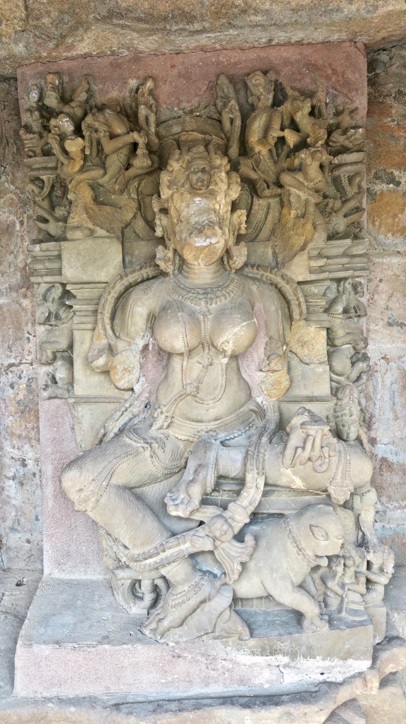
Photo: R. Barz, 2017
Sculpture of Shri Kshatradharmini at
Bheraghat
My conviction about this is strengthened
when I look at the image of another Bheraghat yogini, Shri Audara (Śrī
Auḍārā) in chamber 18. The meaning of Shri Audara’s name is uncertain.
It may
identify her as being from the region of Oḍra, now Odisha.
This yogini has a human face, a sword
in one of her two right hands and a necklace and belt which are studded
with human heads or skulls. These attributes have already been met with
when discussing Shri Kshatradharmini and they will be encountered in the
other Bheraghat and Hirapur yoginis with the same significance. For us
tonight, the important thing about Shri Audara is that her vehicle which
expresses her essence is a naked man with a partially erect penis.
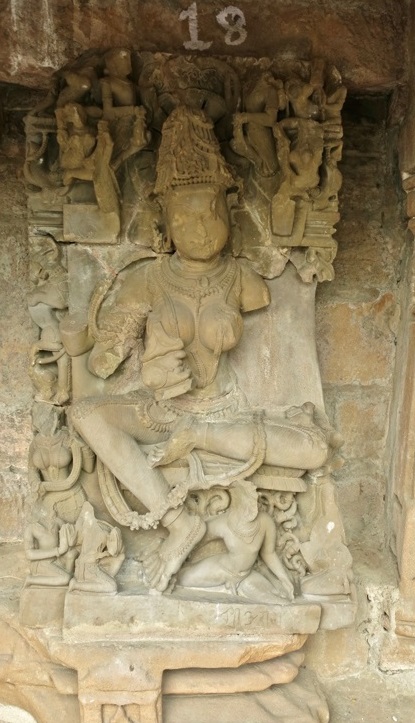
Photo: R. Barz, 2017
Sculpture of Shri Audara at Bheraghat
This naked man, who has no marks of
divinity and so must be human, is not identified or associated with any
Hindu mythological figure by any of the modern researchers who have
investigated yogini temples. For instance, the pioneer of yogini
scholars R.D. Banerji called him simply “a nude male”.
What does a nude male say about the essence of Shri Audara? If the work
of an authority on yogini temples can give no further insight beyond
that he is a man without clothes, I think we are justified in looking at
this yogini and her vehicle from a Jungian perspective. If Shri Audara
is taken as equivalent to the anima, then this nude male can represent a
human man just discovering in the yogini the feminine side of his
psyche. Judging from his nakedness and half erect penis, he has some
distance to go to full individuation as a complete, integrated human
being. Such an interpretation isn’t so far from tantric thought since
all human beings who don’t practice tantra are seen as
pashu (paśu), the Sanskrit word for ‘domestic animal, tethered beast’.
Pashu can take refuge in Shri Audara and seek deliverance through her
from their state of naked helplessness for she has in her essence a
naked man.
It is also possible to invert the Jungian symbolism of
Shri Audara and see her as a woman and the naked man as her animus.
If there is any truth
in these speculations, then there should be at Bheraghat and Hirapur
sculptures depicting a yogini-anima with a fully individuated man. In
fact, there are 10 sculptures at Bheraghat and 3 at Hirapur which would
meet this requirement. In these, a yogini is seated over a bearded male
figure of much higher status than the naked man under Shri Audara.
One of the best-preserved of these statues is
in chamber 10 at Bheraghat and features the yogini Śrī Vībhatsā, whose
name means ‘disgusting, hideous, grim’ in Sanskrit. Shri Vibhatsa’s
imagery with her belt and anklet of human heads is similar to that of
Shri Kshatradharmini and Shri Audara. In one of her left hands Shri
Vibhatsa grasps a shield, showing that her nature is both warlike and
protective. As her face is intact we can see that Shri Vibhatsa’s eyes
are starting out of their sockets in fury and her tongue is lolling out
in unrestrained passion. Nonetheless, her body is attractive. To me, she
is second to none in her effectiveness when seen as an anima. But it is
the male figure lying under her lotus throne who must have most of our
attention.
This male figure with curly hair and beard and
a moustache is a person of consequence, for his ear lobes have been
distended by the plugs that marked high social position in ancient India
and he is wearing a kilt of fine, sheer cloth with a necklace, belt and
anklets. He has fangs in his mouth and a vertical third eye in the
middle of his forehead. With wide open eyes he gazes upward toward Shri
Vibhatsa with an expression of something very like rapture on his
smiling face.
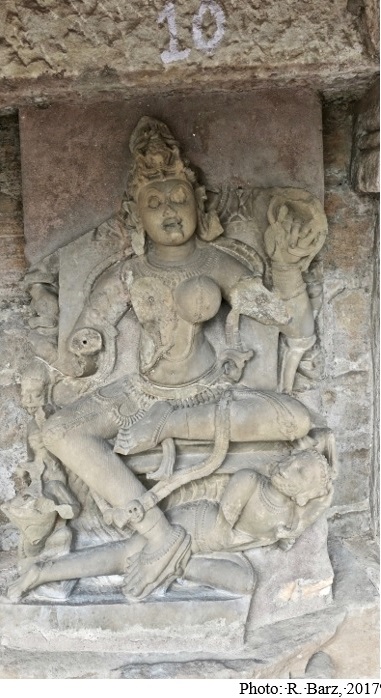
Sculpture of Shri Vibhatsa at Bheraghat
Who is this bearded,
fanged male? According to R.D. Banerji, he is no more than “a bearded
male”
and the other yogini authorities follow him in this opinion. For a
scholar of the Hirapur yogini images, the same bearded male under a
yogini in the fifteenth chamber sculpture there is simply “a demon”.
It is surprising that these investigators have not recognised this
bearded male as Shiva’s emanation Bhairava. The vertical third eye in
his forehead is an immediate disclosure of his relationship to Shiva.
Furthermore, his curly hair, beard and moustache identify him as
Bhairava as described by the respected authority on Hindu iconography
Jitendra Nath Banerjea.
It is Bhairava who is the goal
of the practitioner of tantra. A man who has left the condition of a
pashu through tantra is a vīra,
originally the Sanskrit word for ‘man’ which came in time to have the
connotation of ‘brave man, hero’. So Bhairava, and in him all men who
are vira, is the vehicle of Shri Vibhatsa and of the other yoginis who
are placed in their images over him. The naked pashu who carries Shri
Audara has become the heroic Bhairava who is the vehicle of Shri
Vibhatsa. I think that Carl Jung would have seen in Bhairava the man who
has come to successful terms with his anima in Shri Vibhatsa.
Bhairava is not the only deity or demigod shown in a similar position
under a Bheraghat or Hirapur yogini. At Bheraghat, two yoginis are
depicted over Garuda, the god Vishnu’s bird-of-prey vehicle, and other
yoginis are sculpted over Narasingh, one of Vishnu’s incarnations, and
Ganesh, the god of beginnings and remover of obstacles. At Hirapur the
yogini in the 46th chamber is the Shakti Kālī holding a
trident and standing on a male figure who, with his third eye and crown
of divinity, is Shiva. Because the line between human and divine is fine
and flexible, in Hindu thought all of these images of gods can also
portray a vira. In Jungian language they all show a fully-integrated man
and his anima.
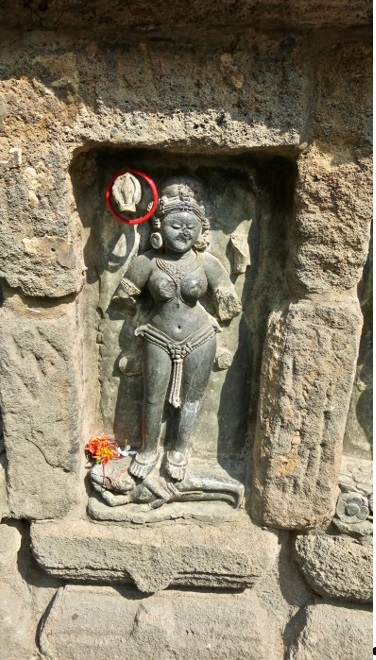
Photo: R.
Barz, 2017
Sculpture of the Shakti Kali
on Shiva at the Hirapur Yogini Temple
Since the whole point of much of tantric
thought is to realise one’s unity with the supreme being it is not at
all bizarre to see in these male deities beneath a yogini men who have
achieved oneness with the supreme being. After all, the most powerful of
Hindu tantric icons is the image of the Shakti Kali dancing on a
prostrate Shiva as in this modern painting from Odisha:
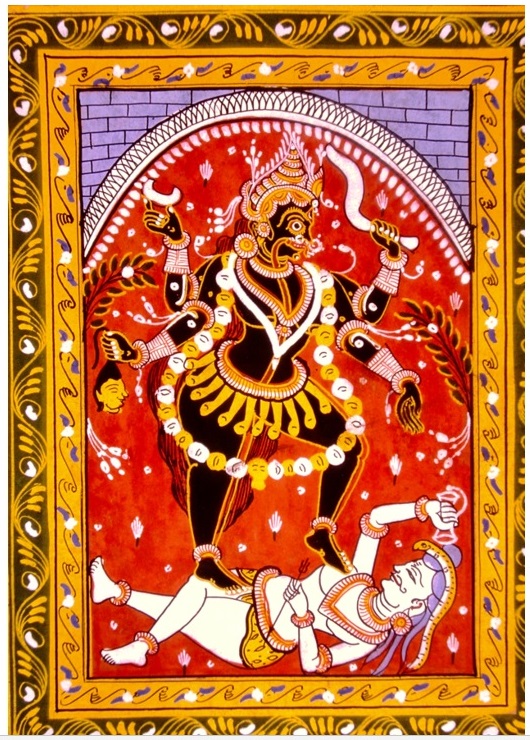
Painting from Odisha of Kali Dancing
on Shiva (c. 1967)
This is an image which conveys the
possibility of unity with Shiva-Shakti. The man or woman who finds that
unity participates on the cosmic level in the primal active energy of
Shakti surging out of, and dancing upon, Shiva who is the presence of
eternal potency.
On the individual level in a Jungian
view this is the interaction of the unconscious anima and the conscious
man and also of the conscious woman in a dance with her unconscious
animus.
On the subject of
women, it must be admitted that in tantric philosophy there is little or
no attention given to a woman who wants to be a
bhairavī, Sanskrit for a ‘a
woman who belongs to Bhairava’, a woman who has become a tantric adept.
A Bhairavi is the female counterpart of a vira. Yet, from ancient Indian
secular and non-tantric writing and from the accounts of modern authors,
we know that there are bhairavis and that there have been bhairavis for
at least a thousand years. There is even an iconographic hint among the
sculptures at Hirapur of the existence of bhairavis.
In niches
in the outer walls of the central pavilion at that temple are four
images of Bhairava. All of them are ithyphallic, as is usual in Bhairava
icons in Odisha. Two of these images include a seemingly male figure
lying prone under the lotus throne of Bhairava just as Bhairava lies
under the image of Shri Vibhatsa at Bheraghat discussed above. The main
difference is that while Bhairava under Shri Vibhatsa at Bheraghat has a
beard, moustache and curly hair, the figure under Bhairava at Hirapur
has short straight hair and no moustache or beard. In any case, the
seemingly male figure cannot be Bhairava as Bhairava is already seated
on his lotus throne above him.
In re-examining this male figure,
one may begin to doubt that it is male at all. The figure has no beard
or moustache. Its short straight hair could be a man’s hair or the
cropped hair of a woman who had renounced ordinary life. Because of the
way the figure’s arms are placed it cannot be known if there are breasts
or not. The figure could just as well be a woman as a man. Can we know
for sure? At the feet of the figure in both of the Hirapur images there
is a small female figure in a tantric dance with a sword held aloft in
one hand and what is probably a skull cup in the other. This figure
could be intended to alert the observer to the fact that the recumbent
figure is a woman, a bhairavi. Here we would have a depiction of a
bhairavi as the vehicle of
Bhairava, proof of the eligibility of
women to practice tantra. To look at the sculpture though Jungian eyes,
we would see a woman in union with her animus Bhairava.
That brings us to the end of this tour of four of the five central
Indian yogini temples, but not to the end of the identity that Carl Jung
would very likely have seen the yoginis of those temples, along with
Bhairava, to share with the anima and animus: a hidden purpose behind
all the cruel sporting with human fate which seems to reflect a superior
knowledge of life’s laws. That is surely endless.
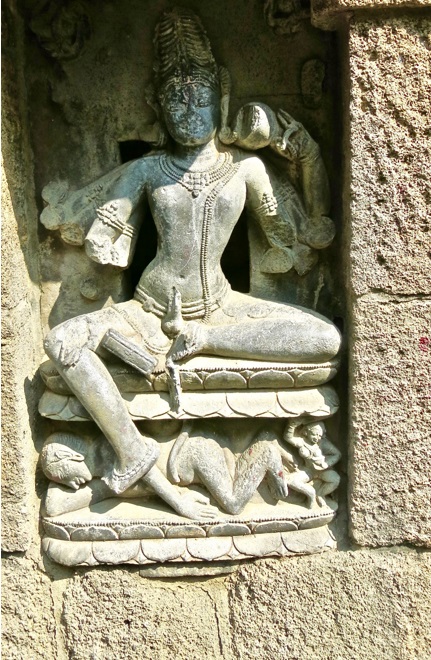
Photo: R. Barz, 2017
Sculpture of Bhairava on a Reclining Woman
with a Dancing Female Figure at Hirapur
R.D. Banerji, The Haihayas
of Tripuri and Their Monuments (Government of India,
Calcutta:1931), p. 58.
Sureś Balabantarāy,
Hīrāpur kā Caũsaṭh Yoginī Mandir (Bahipatra,
Bhubaneshwar:2015), p. 60.
Jitendra Nath Banerjea,
The Development of Hindu
Iconography (University of Calcutta:1956), p. 481 and plate
35, figure 3.
The red ring around Kali’s trident and the flowers at her feet
are the offerings of devotees.
C.G. Jung, “Archetypes of the Collective Unconscious” in
The Collected Works of C.G. Jung
(Routledge, London:1980), vol. 9, part 1, pp. 30-31.
C.G. Jung, “The Phenomenology of the Spirit in Fairytales” in
The Collected Works of C.G. Jung
(Routledge, London:1980), vol. 9, part 1, p. 247.
śakti
in academic transliteration
All dates in this article are CE.
Cakra
in academic transliteration; in Sanskrit the word has the basic
meaning ‘circle’ or ‘wheel’.
Sanskrit for ‘terrible, formidable, ferocious’
‘difficult to approach’ in Sanskrit
Sanskrit for ‘great illusion’
Formerly written Orissa.
Padma
Kaimal,
Scattered Goddesses: Travels with the
Yoginis (Association for
Asian Studies, Ann Arbor:2012).
Vidya
Dehejia,
Yoginī Cult and Temples: A Tantric
Tradition (National
Museum, New Delhi:1986), p. 115 and Krishna Deva,
Temples of Khajuraho
(Archaeological Survey of India, New Delhi:1990), vol. 1, p. 28.
The talk is available at: http://canberrajungsociety.org.au/
~0~
|











